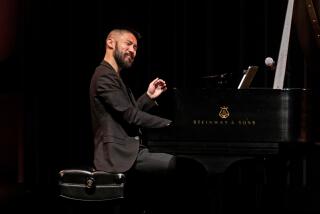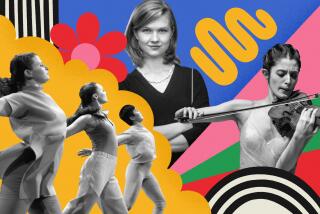Pianist Cyrus Chestnut Tackles Familiar Tunes With a Different Key
- Share via
COSTA MESA — Pianist Cyrus Chestnut doesn’t just interpret songs. He overwhelms them.
Leading his trio before a nearly sold-out audience on Saturday, the second of a two-night stand in Founders Hall of the Orange County Performing Arts Center, Chestnut refashioned both Ellington and Beethoven in ways that, at times, rendered the original compositions barely recognizable. And in remaking these tunes, he gave a most inviting, detailed look at himself.
A formidable presence at the keyboard, Chestnut kept things rich and moving through the 90-minute early show. He frequently opted for a deep, anything-can-happen approach, seldom settled for silence and always had something important to say. Even at its most far-out, his personality-driven style remained utterly engaging.
This immense flood of sound was never overdone or gratuitous. Instead, Chestnut’s detail-oriented, allusion-filled approach proved constantly fascinating. Tempos slowed and accelerated, or changed into different rhythms altogether. Volume swung from shouts to whispers. A certain fervor infused everything the gospel-minded pianist played.
Aiding Chestnut were bassist Steve Kirby, whose astute responsiveness allowed the pianist to wander where he would, and drummer Alvester Garnett, a particularly musical percussionist who offered dynamic shading and accent, even setting aside his sticks at one point to play with his hands.
Garnett used that hand-and-foot approach on Ellington’s “Caravan,” developing a galloping, conga-like sound punctuated by the bass drum and hi-hat cymbal. Chestnut rode into this fray with an uncharacteristically spare, two-notes-at-an-octave unison before developing a more complicated chordal attack.
Playing solo, Chestnut completely reworked Beethoven’s familiar “Fur Elise” with mischievous intent, employing a skippy, Thelonious Monk-like rhythm at one point, a ragtime approach at another.
His delectable, Erroll Garner-influenced reading of “The More I See You” metamorphosed into a stride-heavy, Fats Waller-sized barrel house reading.
Chestnut’s original material, without the touchstone of familiarity, still rolled through a variety of moods. His pensive “Blues From the East” showed that the pianist, despite all the flash, has a reserved, romantic side as well.
Chestnut closed the performance with a rollicking version of “Stompin’ at the Savoy,” a treatment that opened quietly with Garnett’s tingling triangle hits before the bass and piano jumped in to dance up a figurative storm. Chestnut had delivered on an earlier promise to the audience that they would leave with smiles on their faces.
More to Read
The biggest entertainment stories
Get our big stories about Hollywood, film, television, music, arts, culture and more right in your inbox as soon as they publish.
You may occasionally receive promotional content from the Los Angeles Times.










